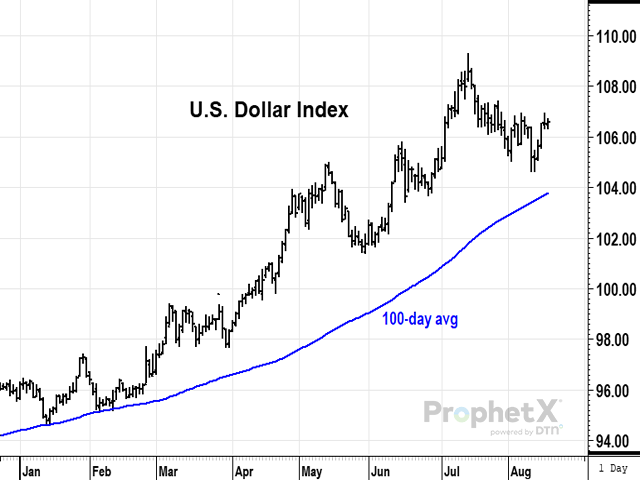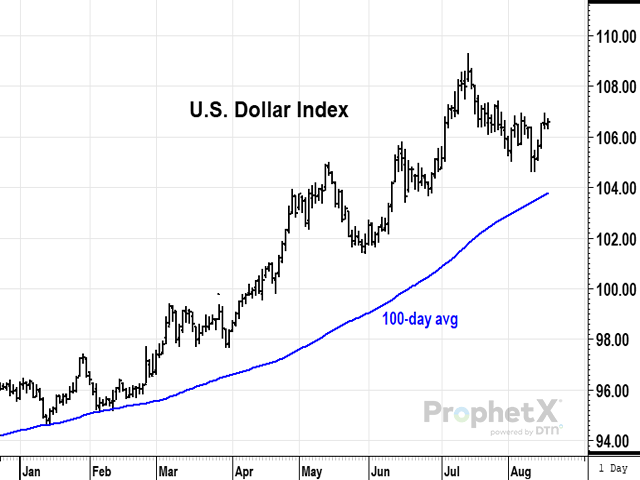An Urban's Rural View
What Moves Speculators to Sell Ag Futures
Who cares about the dollar?
That was the question DTN Contributing Analyst Elaine Kub asked in a column last May, and it was a good one. (https://www.dtnpf.com/…)
At the time, the dollar was strong, but corn, soybeans and wheat futures were defiantly high. From a farmer's standpoint, it looked like no harm, no foul. Who cares, then?
Elaine quickly answered her own question, pointing out that "over a long enough time frame," the dollar can indeed be a major driver of ag-commodity prices. But there's a shorter answer to the who-cares question: speculators.
It's the speculators, the "noncommercials," who move futures prices. The "commercials" -- farmers, grain elevators and others who use futures to hedge -- tend not to have as much money in the futures market as the noncommercials. They tend to respond to the hedging opportunities the noncommercials offer.
It was the speculators who built up a huge collective net-long position in ag and other commodities in the wake of COVID these last couple of years. And it was the specs who began rushing to dump their long positions earlier this year, sparking a winding down that recently touched near-bottom.
The dollar is one of the reasons for those sales. The specs care about the dollar.
P[L1] D[0x0] M[300x250] OOP[F] ADUNIT[] T[]
Now, to be sure, there are many times when commercials care about it as well. When a strong dollar holds U.S. ag exports in check, or a weak dollar promotes them -- when, in short, the currency fundamentally affects demand for the physical commodity -- everyone cares about the dollar.
So far this year, though, U.S. ag exports have been strong despite the greenback's strength. In February USDA forecast record exports for fiscal 2022 and in May USDA boosted its forecast.
The dollar, meanwhile, was at its high for the year. (https://www.wsj.com/…)
Because exports were strong, the commercials didn't care about the dollar. The noncommercials did. As it rose, they sold.
Why did the specs care? One possible reason is they simply didn't share USDA's optimism about exports. Another is concerns about the dollar's impact on financial flows, not exports, moved the specs to sell.
The financial explanation makes more sense. The specs know if the world is badly short of food, a strong dollar won't stanch U.S. ag exports. But they also know the dollar is strong in part because the Federal Reserve is raising interest rates, a signal to investors to switch into "risk off" mode. They know, too, a strong dollar quells foreigners' enthusiasm for investing in U.S. financial assets.
Futures contracts for ag, oil and other commodities are among the riskiest financial assets. During a risk-off period, they would be among the first U.S. assets domestic and foreign investors might want to shed, or at least avoid buying.
Anticipating this change in investor behavior, hedge funds and other speculators rushed to be the first to the exit. They stumbled all over each other in their eagerness to sell. By the end of July, the noncommercials' long position was essentially unwound.
This explanation has the advantage of being consistent with what we know about a key difference between commercials and noncommercials. If you have corn to buy or sell, you worry a lot about supply-and-demand fundamentals for corn. If you're just trying to profit by betting on the direction of corn futures, you worry a lot about what other bettors are going to do.
And depending on the circumstances, the moves of other bettors can be driven more by interest rates and foreign-investment flows than ending stocks. In other words, by the dollar.
This can produce results that look screwy, and not just to farmers. In a Wall Street Journal article, Goldman Sachs analysts described the specs' sell-off as "de-linked from physical fundamentals and driven by financial liquidation." JP Morgan analysts said it "is masking profound dislocations in global agricultural trade flows and in no way alleviates the risks of physical supply shortages through 2023." (https://www.wsj.com/…)
The good news for farmers is futures can't stay delinked from fundamentals forever. As DTN Lead Analyst Todd Hultman put it recently, "Supplies of grain do matter and now that speculative positions have largely been deflated, there is room for prices to reflect a more bullish view."
Urban Lehner can be reached at urbanize@gmail.com
(c) Copyright 2022 DTN, LLC. All rights reserved.








Comments
To comment, please Log In or Join our Community .